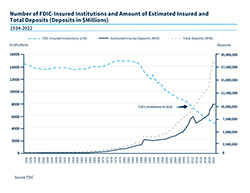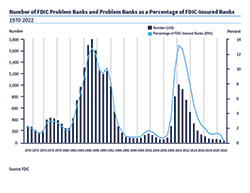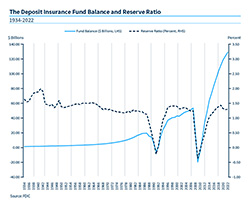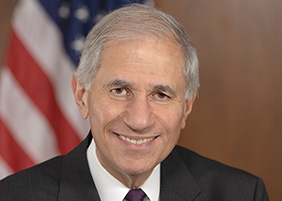July 21, 2010
The Dodd-Frank Wall Street Reform and Consumer Protection Act of 2010 is signed into law by President Barack H. Obama. This law, which is aimed at addressing the causes of the financial crisis, is the most comprehensive legislative reform of the U.S. financial sector since the Great Depression. Among its extensive provisions, the statute sought to improve supervision of systemically important nonbank financial companies and large bank holding companies. It also sought to improve consumer financial protection and mortgage lending practices and enhance the transparency of financial derivatives.
The statue:
- Abolishes the Office of Thrift Supervision (OTS) created in 1989 to supervise thrifts and transfers thrift supervision to the OCC and the FDIC for federally and state-chartered thrifts, respectively. Thrift holding companies will be supervised by the Federal Reserve.
- Creates the Consumer Financial Protection Bureau (CFPB), which has authority for specified federal consumer protection laws and examination and enforcement authority for many nonbank financial service providers and insured depository institutions with assets over $10 billion. The Director of the CFPB replaces the Director of the OTS on the FDIC's Board of Directors.
- Creates the Financial Stability Oversight Council (FSOC), of which the FDIC is a member. The FSOC has the authority to designate certain nonbank financial companies for Federal Reserve supervision and to recommend heightened supervision of nonbank financial companies and bank holding companies with more than $50 billion in assets.
Some of the most important provisions in the law concerning the FDIC are as follows:
- Permanently increases the standard maximum insurance amount to $250,000, retroactive to January 1, 2008.
- Temporarily provides unlimited deposit insurance coverage for noninterest- bearing transaction accounts for two years from December 31, 2010, through December 31, 2012, separate from and in addition to standard deposit insurance coverage.
- Changes the assessment base used to calculate deposit insurance premiums to average consolidated total assets minus average tangible equity.
- Eliminates the maximum limitation on the Designated Reserve Ratio and raises the minimum of that ratio from 1.15 to 1.35 percent of estimated insured deposits.
- Directs the FDIC, when setting assessments, to offset the effect on small banks of the increase in the minimum reserve ratio.
- Removes the ability of the FDIC to provide open-bank assistance to a failing financial institution.
- Expands the role of the FDIC as receiver: the FDIC can now be appointed receiver for a failed systemically important nonbank financial company or large interconnected bank holding company, although no money from the DIF can be used in orderly liquidation under Title II of the law.
https://www.fdic.gov/about/financial-reports/report/2010annualreport/ar10doddfrank.pdf
December 2010
In the wake of the financial crisis, Basel III, which comprises a new set of capital and liquidity reforms, is proposed. These reforms include stricter capital requirements, an additional layer of common equity (a capital conservation buffer), a countercyclical capital buffer, a leverage ratio to apply regardless of risk weighting, and a minimum liquidity ratio (the liquidity coverage ratio) meant to provide cash to cover funding during periods of stress. The post-crisis reforms, with additional reforms added from 2011 to 2016, were finalized in 2017.
https://www.bis.org/bcbs/history.htm#basel
December 20, 2010
The FDIC Board sets the Designated Reserve Ratio at 2 percent for 2011 under a long-range fund management policy adopted following the passage of Dodd-Frank. This plan is intended to increase the likelihood that the DIF would reach a level sufficient to withstand a future crisis. As part of the plan, the FDIC suspends dividends indefinitely when the fund reserve ratio exceeds 1.5 percent, and instead, will progressively lower assessment rates when the reserve ratio exceeds first 2 percent and then 2.5 percent.
December 31, 2010
There are approximately 7,700 FDIC-insured institutions with estimate insured deposits of about $6.3 trillion.

Chart of the number of FDIC-insured institutions and amount of estimated insured and total deposits - 2010
2010
By year-end, 157 insured depository institutions fail, the most of any year during the crisis. At year-end, the number of problem institutions rises to 884.

Chart of the number of bank and thrift failure and assistance transactions in the United States

Chart of the number of problem banks and problem banks as percentage of FDIC-insured banks
April 1, 2011
The FDIC revises its pricing methodology for large banks and highly complex institutions. The changes are meant to capture risk closer to the time a bank assumes the risk, better differentiate risks posed by banks during good times based on how the banks would fare during an economic downturn, and account more accurately for potential FDIC losses if a large bank fails.
June 30, 2011
The DIF balance and reserve ratio turn positive, having been negative since third quarter 2009. <

FDIC Deposit Insurance Fund Balance and Researve Ratio, 1934-2022
July 9, 2011

2011
By year-end, 92 insured depository institutions fail, far fewer than in 2010. The number of problem institutions also declines slightly from a year before, to 813.

Chart of the number of bank and thrift failure and assistance transactions in the United States

Chart of the number of problem banks and problem banks as percentage of FDIC-insured banks
November 29, 2012

2012
By year-end, 51 insured depository institutions fail, one-third the number that failed in 2010, and the number of problem institutions has dropped to 651.

Chart of the number of bank and thrift failure and assistance transactions in the United States

Chart of the number of problem banks and problem banks as percentage of FDIC-insured banks
2013
By year-end, just 24 insured depository institutions (IDIs) fail, one fewer than the first year of the banking crisis, and the number of problem institutions has fallen to 467. It will take several years for problem bank numbers to return to pre-crisis levels.

Chart of the number of bank and thrift failure and assistance transactions in the United States

Chart of the number of problem banks and problem banks as percentage of FDIC-insured banks
March 2016
As required by Dodd-Frank, the FDIC approves deposit insurance assessment surcharges on insured depository institutions with total assets of $10 billion or more. The purpose of the surcharge was to offset the effect on small banks of the requirement to increase the reserve ratio to 1.35 percent. These surcharges begin in third quarter 2016, when the reserve ratio exceeded 1.15 percent and are to last until the quarter in which the reserve ratio reaches or exceeds 1.35 percent.
https://www.fdic.gov/news/financial-institution-letters/2016/fil16058.pdf
July 1, 2016
The FDIC revises its assessment pricing methodology for small, established banks (generally banks that have been FDIC-insured for at least five years and have less than $10 billion in assets). The new methodology uses financial ratios and CAMELS component ratings instead of risk categories to limit the rates that these banks can be charged. Looking back, the new system would have better distinguished between banks that later failed and those that did not than the risk-category system it replaces.
https://www.fdic.gov/resources/deposit-insurance/deposit-insurance-fund/dif-assessments.html
June 5, 2018

